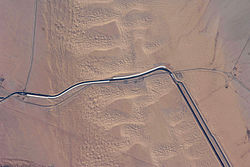| All-American Canal | |
|---|---|
 View of about 15 kilometers (9.3 mi) of the All-American Canal just west of Yuma, Arizona. Note: North is to upper right. | |
| Location | |
| Country | U.S. |
| State | California |
| Physical characteristics | |
| Mouth | |
• coordinates | 32°52′33″N 114°28′21″W / 32.875876°N 114.472448°W |
 | |
The All-American Canal is an 82-mile-long (132 km) aqueduct, located in southeastern California. It conveys water from the Colorado River into the Yuma Project, the Imperial Valley, and to nine cities. It is the Imperial Valley's only water source, and replaced the Alamo Canal, which was located mostly in Mexico. The Imperial Dam, about 30 miles (48 km) northeast of Yuma, Arizona on the Colorado River, diverts water into the All-American Canal, which runs to just west of Calexico, California before its last branch heads mostly north into the Imperial Valley. Smaller canals branching off the All-American Canal move water into the Yuma Valley and the Imperial Valley. These canal systems irrigate up to 630,000 acres (250,000 ha) of crop land and have made possible a greatly increased crop yield in this area, originally one of the driest on earth. It is the largest irrigation canal in the world,[1] carrying a maximum of 26,155 cubic feet per second (740.6 m3/s). Agricultural runoff from the All-American Canal drains into the Salton Sea.
The All-American Canal runs parallel to the Mexico–California border for several miles. With over 500 people having drowned in the canal since its completion, it has been called "the Most Dangerous Body of Water in the U.S."[2]
The California Office of Environmental Health Hazard Assessment has issued an advisory for any fish caught in the All-American Canal due to elevated levels of mercury, PCBs, and selenium.[3]
- ^ Cite error: The named reference
NASAwas invoked but never defined (see the help page). - ^ "The Deadly Passage of the All-American Canal". CBS News. 30 April 2010. Retrieved 30 July 2021.
- ^ Admin, OEHHA (2018-12-17). "All-American Canal". OEHHA. Retrieved 2018-12-21.
